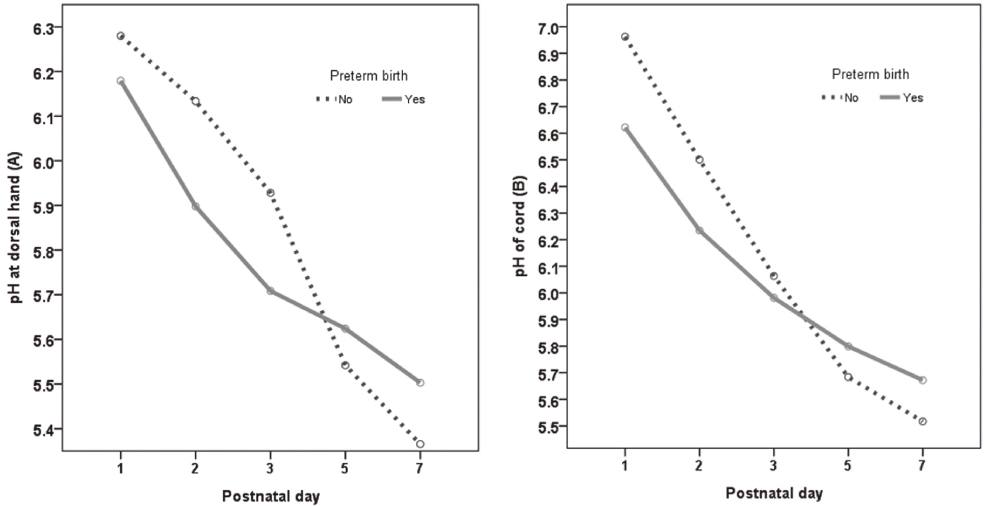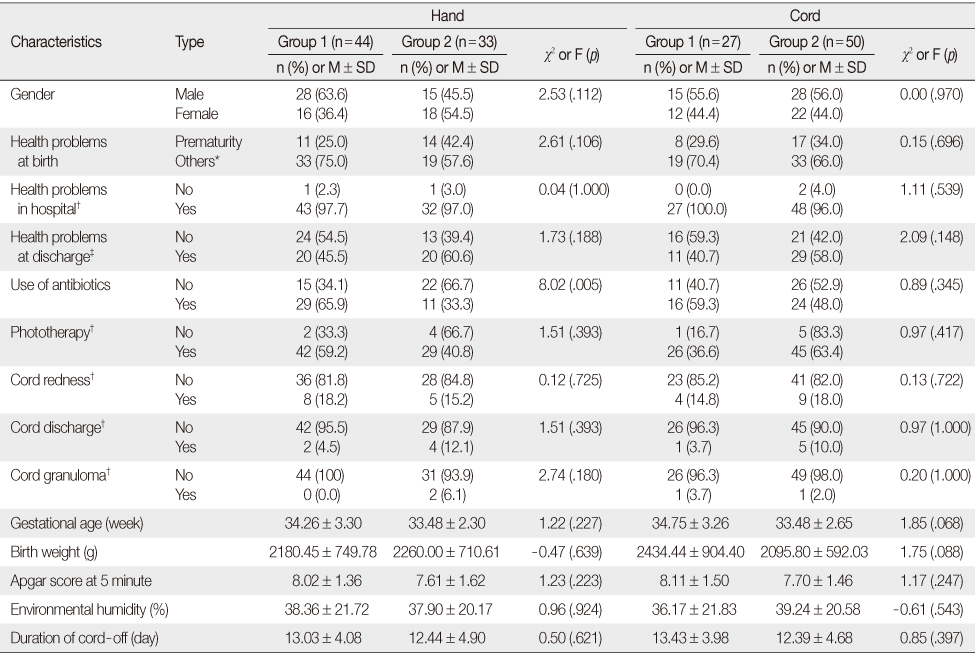Articles
- Page Path
- HOME > J Korean Acad Nurs > Volume 43(1); 2013 > Article
-
Original Article
- pH, Temperature, Hydration of the Stratum Corneum of the Dorsal Hand and the Cord Area, and Acid Mantle Formation during Early Days of life in High-risk Newborns
- Youngmee Ahn, Min Sohn, Sangmi Lee, Mijin Lee
-
Journal of Korean Academy of Nursing 2013;43(1):30-38.
DOI: https://doi.org/10.4040/jkan.2013.43.1.30
Published online: February 28, 2013
Department of Nursing, College of Medicine, Inha University, Incheon, Korea.
- Address reprint requests to: Ahn, Youngmee. Department of Nursing, Inha University, 253 Yonghyun-dong, Nam-gu, Incheon, 402-751, Korea. Tel: +82-32-860-8207, Fax: +82-32-874-5880, aym@inha.ac.kr
© 2013 Korean Society of Nursing Science
Abstract
-
Purpose
- The study was done to explore variations in physiologic parameters of the stratum corneum (SC) of the dorsal hand and cord area during early days of life in high-risk newborns.
-
Methods
- In this longitudinal study, a total of 77 high-risk newborns were assessed for pH, temperature and hydration of the SC of the dorsal hand and the cord area on the 1st, 2nd, 3rd, 5th and 7th days of life.
-
Results
- Results showed that an acid mantle (AM) was formed in 57.1% for dorsal hand and 35.1% for cord area, implying significant delay regardless of decrease in pH (F=103.60, p<.001), and hydration (F=4.00, p=.003) across days in both areas. Peripheral hypothermia with low hydration level was also observed in both areas. There was a positive relation between hydration and temperature (.14<r<.27, p<.010), and negative relation between hydration and pH in both areas (-.23<r<-.15, p<.010). Antibiotics may play a positive role in AM formation.
-
Conclusion
- High-risk newborns may experience delay in acid mantle formation on SC, hypothermia and decreases in hydration on peripheral sites during the first 7 days of life.
This research was supported by the Basic Science Research Program through the National Research Foundation of Korea (NRF) funded by the Ministry of Education, Science and Technology (No. 2010-0021971).
- 1. Ahn Y, Shin E. Assessment of hydration on the stratum corneum and the influencing factors in neonates. J Korean Acad Nurs. 2007;37(5):781–789.ArticlePDF
- 2. Behrendt H, Green M. Skin pH pattern in the newborn infant. AMA J Dis Child. 1958;95(1, Part 1):35–41. http://dx.doi.org/10.1001/archpedi.1958.02060050037006.ArticlePubMed
- 3. Capone KA, Dowd SE, Stamatas GN, Nikolovski J. Diversity of the human skin microbiome early in life. J Invest Dermatol. 2011;131(10):2026–2032. http://dx.doi.org/10.1038/jid.2011.168.ArticlePubMedPMC
- 4. Cartlidge P. The epidermal barrier. Semin Neonatol. 2000;5(4):273–280. http://dx.doi.org/10.1053/siny.2000.0013.ArticlePubMed
- 5. Chiou YB, Blume-Peytavi U. Stratum corneum maturation. A review of neonatal skin function. Skin Pharmacol Physiol. 2004;17(2):57–66. http://dx.doi.org/10.1159/000076015.ArticlePubMedPDF
- 6. Curley MAQ, Moloney-Harmon PA. Critical care nursing for infants and children. 2001;2nd ed. Philadelphia, W. B. Saunders Company.
- 7. Fluhr JW, Darlenski R, Taieb A, Hachem JP, Baudouin C, Msika P, et al. Functional skin adaptation in infancy-almost complete but not fully competent. Exp Dermatol. 2010;19(6):483–492. http://dx.doi.org/10.1111/j.1600-0625.2009.01023.x.ArticlePubMed
- 8. Fox C, Nelson D, Wareham J. The timing of skin acidification in very low birth weight infants. J Perinatol. 1998;18(4):272–275.PubMed
- 9. Gardner SL, Carter B, Enzman-Hines MI, Hernandez JA. Merenstein & Gardner's handbook of neonatal intensive care. 2011;7th ed. St. Louis, MO, Mosby.
- 10. Hoeger PH, Enzmann CC. Skin physiology of the neonate and young infant: A prospective study of functional skin parameters during early infancy. Pediatr Dermatol. 2002;19(3):256–262.ArticlePubMedPDF
- 11. Knobel RB, Guenther BD, Rice HE. Thermoregulation and thermography in neonatal physiology and disease. Biol Res Nurs. 2011;13(3):274–282. http://dx.doi.org/10.1177/1099800411403467.ArticlePubMedPDF
- 12. Lashkari HP, Chow P, Godambe S. Aqueous 2% chlorhexidine-induced chemical burns in an extremely premature infant. Archives of Disease in Childhood. Arch Dis Child Fetal Neonatal Ed. 2012;97(1):F64. http://dx.doi.org/10.1136/adc.2011.215145.ArticlePubMed
- 13. Lee JY, Koscheyev VS, Kim JH, Warpeha JM. Thermal dynamics of core and periphery temperature during treadmill sub-maximal exercise and intermittent regional body cooling. J Korean Soc Living Environ Syst. 2009;16(2):89–100.
- 14. Lee SH, Lee SE, An SK, Hong SP, Kim HJ, Lee HK, et al. Skin barrier. 2010;Seoul, Ryo Moon Gak.
- 15. Mancini AJ. Skin. Pediatrics. 2004;113:4 Suppl. 1114–1119.ArticlePubMedPDF
- 16. Peck SM, Botwinick IS. The buffering capacity of infants' skins against an alkaline soap and a neutral detergent. J Mt Sinai Hosp N Y. 1964;31:134–137.PubMed
- 17. Pezzati M, Rossi S, Tronchin M, Dani C, Filippi L, Rubaltelli FF. Umbilical cord care in premature infants: The effect of two different cord-care regimens (salicylic sugar powder vs chlorhexidine) on cord separation time and other outcomes. Pediatrics. 2003;112(4):e275. http://dx.doi.org/10.1542/peds.112.4.e275.ArticlePubMedPDF
- 18. Reynolds PR, Banerjee S, Meek JH. Alcohol burns in extremely low birthweight infants: Still occurring. Archives of Disease in Childhood. Arch Dis Child Fetal Neonatal Ed. 2005;90(1):F10. http://dx.doi.org/10.1136/adc.2004.054338.PubMedPMC
- 19. Rutter N. The dermis. Semin Neonatol. 2000;5(4):297–302. http://dx.doi.org/10.1053/siny.2000.0016.ArticlePubMed
- 20. Sahni R, Schulze KF, Ohira-Kist K, Kashyap S, Myers MM, Fifer WP. Interactions among peripheral perfusion, cardiac activity, oxygen saturation, thermal profile and body position in growing low birth weight infants. Acta Paediatr. 2010;99(1):135–139. http://dx.doi.org/10.1111/j.1651-2227.2009.01514.x.ArticlePubMedPMC
- 21. Schmid-Wendtner MH, Korting HC. The pH of the skin surface and its impact on the barrier function. Skin Pharmacol Physiol. 2006;19(6):296–302. http://dx.doi.org/10.1159/000094670.ArticlePubMedPDF
- 22. Stamatas GN, Nikolovski J, Mack MC, Kollias N. Infant skin physiology and development during the first years of life: A review of recent findings based on in vivo studies. Int J Cosmet Sci. 2011;33(1):17–24. http://dx.doi.org/10.1111/j.1468-2494.2010.00611.x.ArticlePubMed
- 23. Visscher M, Odio M, Taylor T, White T, Sargent S, Sluder L, et al. Skin care in the NICU patient: Effects of wipes versus cloth and water on stratum corneum integrity. Neonatology. 2009;96(4):226–234. http://dx.doi.org/10.1159/000215593.ArticlePubMedPDF
- 24. Yosipovitch G, Maayan-Metzger A, Merlob P, Sirota L. Skin barrier properties in different body areas in neonates. Pediatrics. 2000;106(1):105–108. http://dx.doi.org/10.1542/peds.106.1.105.ArticlePubMedPDF
- 25. Zupan J, Garner P, Omari AA. Topical umbilical cord care at birth. Cochrane Database Syst Rev. 2004;CD001057. http://dx.doi.org/10.1002/14651858.CD001057.pub2.
REFERENCES



Figure & Data
REFERENCES
Citations

- Development of a Nursing Guideline for Improving Skin Integrity in High-Risk Infants
Young Mee Ahn, Sang Mi Lee, Jung Ae Cho
The Journal of Continuing Education in Nursing.2020; 51(5): 238. CrossRef - Hydration and pH of the Stratum Corneum in High-risk Newborns in the First 2 Weeks of Life
Young Mee Ahn, Min Sohn, Sangmi Lee
Child Health Nursing Research.2018; 24(3): 345. CrossRef - Hypothermia and Related Factors in High-Risk Infants
Youngmee Ahn, Min Sohn, Namhee Kim, Narae Kang, Seungyeon Kang, Eunmi Jung
Child Health Nursing Research.2017; 23(4): 505. CrossRef - Glucose and pH of Oral Secretions in Newborns
Namhee Kim, Youngmee Ahn
Child Health Nursing Research.2017; 23(3): 353. CrossRef - Two methods of cord care in high-risk newborns
Youngmee Ahn, Min Sohn, Yonghoon Jun, Eunyoung Lee, Sangmi Lee
Journal of Child Health Care.2015; 19(1): 118. CrossRef

Figure 1
pH, Temperature and Hydration Changes for Dorsal Hand and Cord Area during First 7 Days of Life (N=77)
Correlation among pH, Temperature and Hydration and Age for Dorsal Hand and Cord Area (N=77)
BT=Body temperature; ET=Environmental temperature; EH=Environmental humidity.
Frequency of Acid Mantle (AM) Groups for Dorsal Hand and Cord Area for first 7 Days of Life (N=77)
Group 1=Group with acid mantle formation; Group 2=Group with no acid mantle formation.
Factors relating to Acid Mantle Formation for Dorsal Hand and Cord Area at the 7th Day of Life (N=77)
Group 1=Group with acid mantle formation; Group 2=Group without acid mantle formation.
*Transient tachypnea of newborns, Nuchal cord, Meconium aspiration, Twin, Intrauterine growth retardation et al.; †Fisher's exact test; ‡Intraventricular hemorrhage grade<=1 et al.; §n=57.
BT=Body temperature; ET=Environmental temperature; EH=Environmental humidity.
Group 1=Group with acid mantle formation; Group 2=Group with no acid mantle formation.
Group 1=Group with acid mantle formation; Group 2=Group without acid mantle formation. *Transient tachypnea of newborns, Nuchal cord, Meconium aspiration, Twin, Intrauterine growth retardation et al.; †Fisher's exact test; ‡Intraventricular hemorrhage grade<=1 et al.; §n=57.
 KSNS
KSNS
 E-SUBMISSION
E-SUBMISSION


 Cite
Cite

